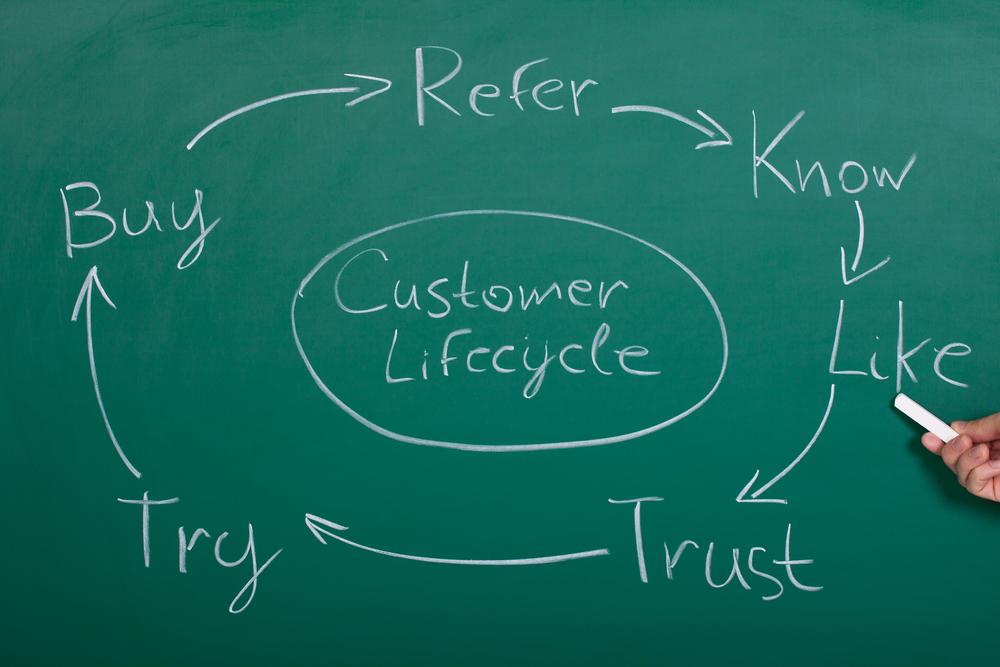Perhaps the biggest reason for content marketing’s explosion is that today’s B2B consumers are so intrinsically different than they were even a decade ago. Today’s decision maker is self-reliant and more inclined to do his or her own research before contacting a company directly.
In fact, research from CEB Global suggests that 57 percent of the purchasing decision is complete by the time a consumer calls a supplier, and studies from both Gartner and Forrester suggest that number could be as high as 80 percent by 2020.

To keep customers engaged and moving through the buying cycle, businesses must create content that targets each stage of the process. Below is a summary of the various stages of the buying life cycle and what content for each should look like:
Awareness
During the first stage of the buying journey, consumers recognize that they have a need and begin to gather information to help educate themselves. Market-research-driven content can be extremely valuable at this point in the buying process, as these assets offer unbiased research that can be extremely influential to decision makers. For example, if you sell a unified communications (UC) solution, your company’s white paper exploring UC’s collaboration benefits might turn up on the first page of a search for “How do I get better production from my employees?” Additionally, more basic promotions—like flyers, for instance—can be effective for creating basic awareness.
Consideration
At perhaps the most critical part of the process, the buyer begins to evaluate his or her options and compare your product or service to the competition’s. Content that specifically differentiates you from your counterparts, therefore, is critical at this stage; for example, case studies can be especially impactful here. If your business can make a compelling case to customers by providing concrete examples of how your product or service helped solved a real-world problem for a client, you are more likely to move to the front of the buyer’s list of possible vendors.
Purchase
This is where your hard work from the first two stages pays off and the prospect becomes a customer. When a formal business relationship is established, it’s important to be able to offer content that reinforces the idea that the buyer made the right decision. Your website, for instance, should contain data sheets that clearly demonstrate product features and your blog should be populated with stories that offer tips and tricks that help customers derive maximum value from your offerings.
Retention and Upselling
Locking down a sale is great, but your work is far from over. Loyal customers equate to recurring revenue, so you should be sure to include content for existing customers in your overarching content marketing plan. Newsletters and promotional “VIP” email marketing offers are two examples of valuable follow-up tools that can enhance the bond between your company and customers, increasing the chances that the customer will become a repeat buyer and possibly even increase spending in the future.
Evangelism
The final stage in the buying journey is not truly final, because ideally your most loyal customers will become a de facto part of your marketing efforts by spreading your brand message to their own customers and partners. Once you’ve identified your brand evangelists—a customer anxious to share your message and engage other potential customers for you—you can derive even more value from the relationships by conducting interviews with the clients and converting them into client testimonials. When a new “crop” of potential customers makes its way to your website, gated long-form assets like the aforementioned testimonials, downloadable podcasts and e-books can be valuable for capturing critical information about these new leads.
So where will all of this content come from? Effectively targeting prospects at every stage of the buying journey requires the ability to consistently and expertly craft a number of different content types, all with specific aims. Many businesses, however, simply do not have the resources or manpower to execute such a strategy. For those organizations, a content strategy vendor can be invaluable.
If you would like more information about how such a vendor can help you more effectively target consumers, download this white paper entitled “The Virtues of Choosing a Content Strategy Vendor.”
Edited by
Brooke Neuman















